A Study of Resource Allocation and Priority Settings in Healthcare
VerifiedAdded on 2023/06/05
|5
|1195
|361
Essay
AI Summary
This essay explores the critical issues surrounding resource allocation and priority settings within global healthcare systems. It highlights the challenges related to finance, sustainability, and quality, prompting governments to optimize the use of public resources. The essay analyzes different approaches to priority setting, using examples such as the Oregon Medicaid program in the USA and the Dunning report in the Netherlands. These examples illustrate explicit and implicit methods for allocating resources, considering factors like cost-effectiveness, community benefits, and individual responsibilities. The discussion emphasizes the importance of economic evaluation, reaching deserving groups, and balancing societal needs with individual concerns in healthcare resource management. Desklib offers a platform for students to access this essay and a wide range of study tools and resources.
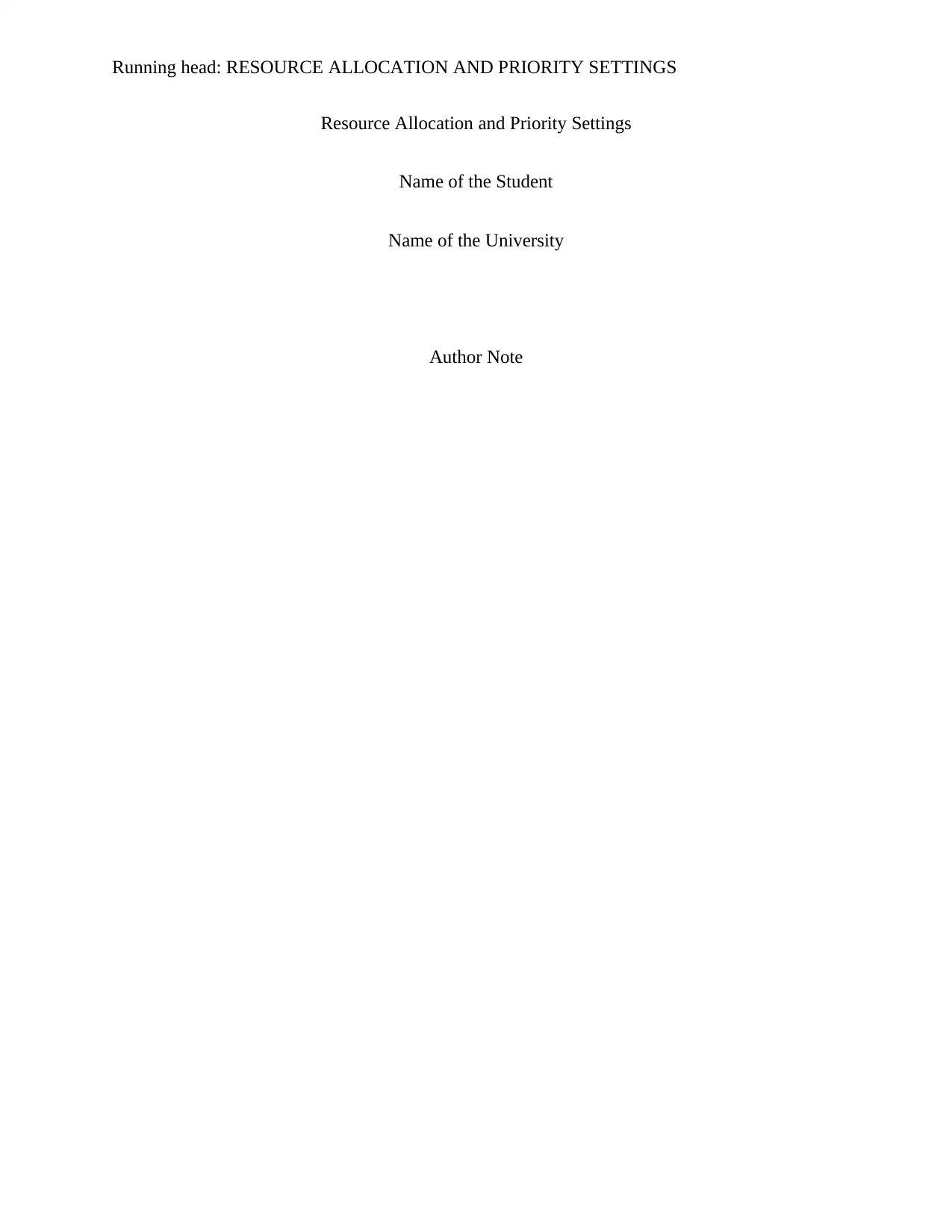
Running head: RESOURCE ALLOCATION AND PRIORITY SETTINGS
Resource Allocation and Priority Settings
Name of the Student
Name of the University
Author Note
Resource Allocation and Priority Settings
Name of the Student
Name of the University
Author Note
Paraphrase This Document
Need a fresh take? Get an instant paraphrase of this document with our AI Paraphraser
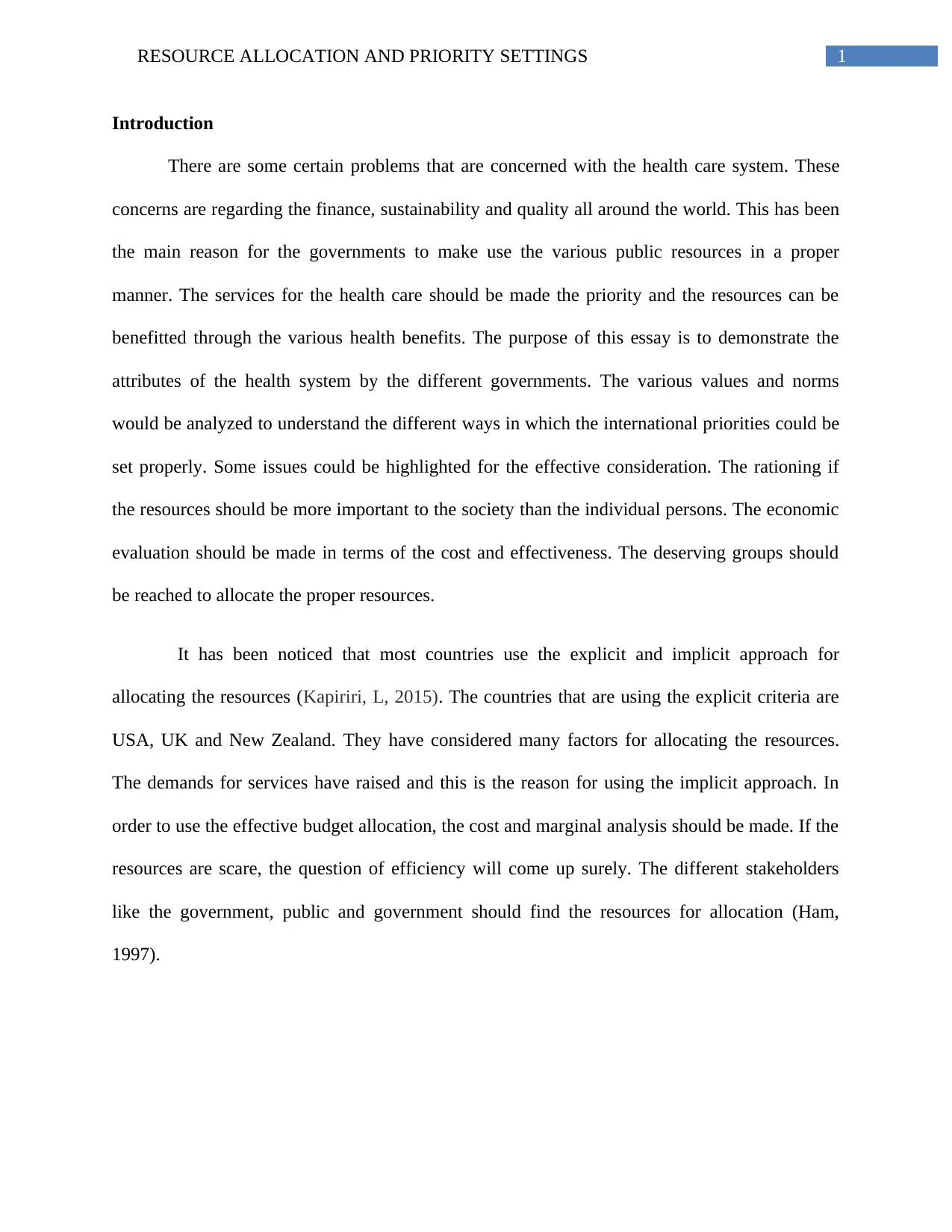
1RESOURCE ALLOCATION AND PRIORITY SETTINGS
Introduction
There are some certain problems that are concerned with the health care system. These
concerns are regarding the finance, sustainability and quality all around the world. This has been
the main reason for the governments to make use the various public resources in a proper
manner. The services for the health care should be made the priority and the resources can be
benefitted through the various health benefits. The purpose of this essay is to demonstrate the
attributes of the health system by the different governments. The various values and norms
would be analyzed to understand the different ways in which the international priorities could be
set properly. Some issues could be highlighted for the effective consideration. The rationing if
the resources should be more important to the society than the individual persons. The economic
evaluation should be made in terms of the cost and effectiveness. The deserving groups should
be reached to allocate the proper resources.
It has been noticed that most countries use the explicit and implicit approach for
allocating the resources (Kapiriri, L, 2015). The countries that are using the explicit criteria are
USA, UK and New Zealand. They have considered many factors for allocating the resources.
The demands for services have raised and this is the reason for using the implicit approach. In
order to use the effective budget allocation, the cost and marginal analysis should be made. If the
resources are scare, the question of efficiency will come up surely. The different stakeholders
like the government, public and government should find the resources for allocation (Ham,
1997).
Introduction
There are some certain problems that are concerned with the health care system. These
concerns are regarding the finance, sustainability and quality all around the world. This has been
the main reason for the governments to make use the various public resources in a proper
manner. The services for the health care should be made the priority and the resources can be
benefitted through the various health benefits. The purpose of this essay is to demonstrate the
attributes of the health system by the different governments. The various values and norms
would be analyzed to understand the different ways in which the international priorities could be
set properly. Some issues could be highlighted for the effective consideration. The rationing if
the resources should be more important to the society than the individual persons. The economic
evaluation should be made in terms of the cost and effectiveness. The deserving groups should
be reached to allocate the proper resources.
It has been noticed that most countries use the explicit and implicit approach for
allocating the resources (Kapiriri, L, 2015). The countries that are using the explicit criteria are
USA, UK and New Zealand. They have considered many factors for allocating the resources.
The demands for services have raised and this is the reason for using the implicit approach. In
order to use the effective budget allocation, the cost and marginal analysis should be made. If the
resources are scare, the question of efficiency will come up surely. The different stakeholders
like the government, public and government should find the resources for allocation (Ham,
1997).
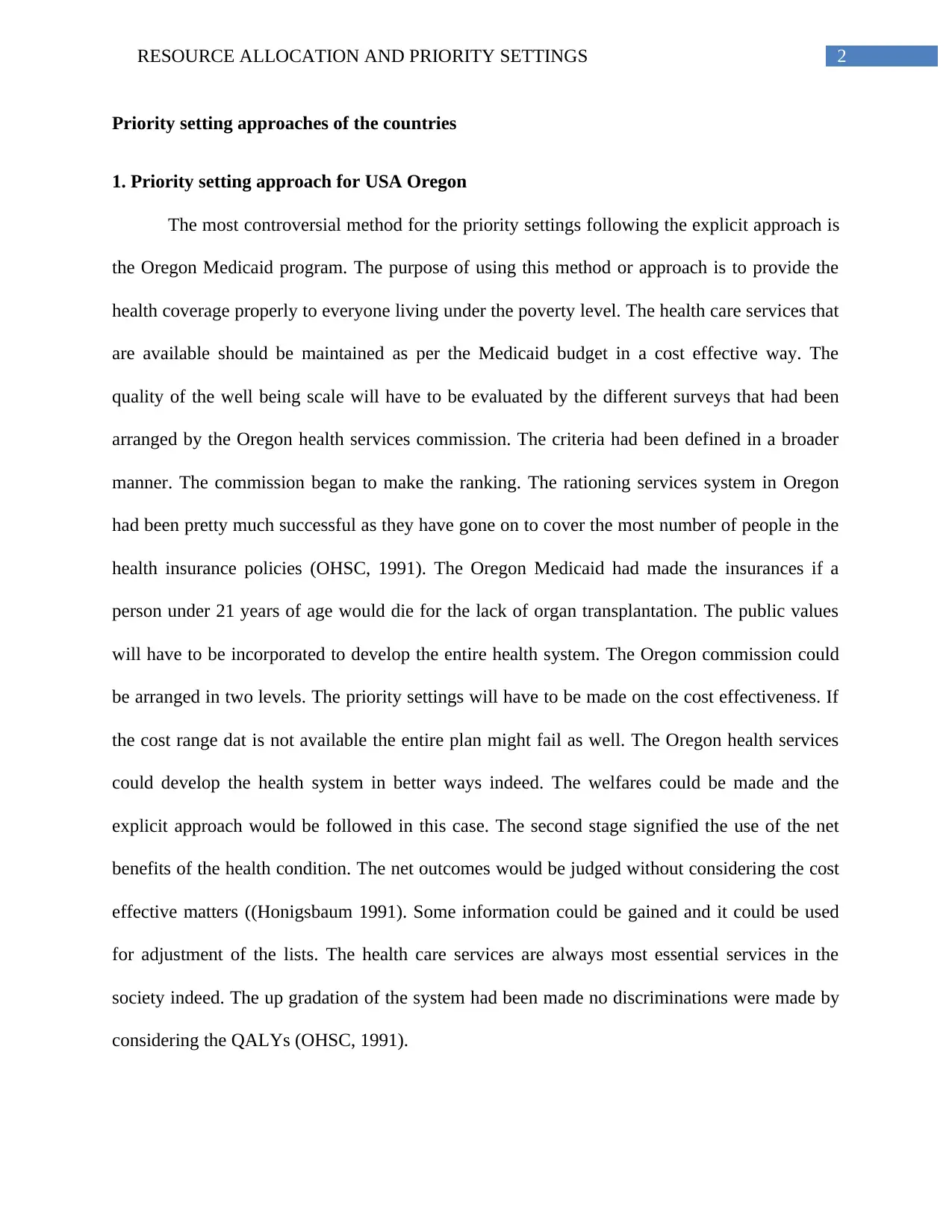
2RESOURCE ALLOCATION AND PRIORITY SETTINGS
Priority setting approaches of the countries
1. Priority setting approach for USA Oregon
The most controversial method for the priority settings following the explicit approach is
the Oregon Medicaid program. The purpose of using this method or approach is to provide the
health coverage properly to everyone living under the poverty level. The health care services that
are available should be maintained as per the Medicaid budget in a cost effective way. The
quality of the well being scale will have to be evaluated by the different surveys that had been
arranged by the Oregon health services commission. The criteria had been defined in a broader
manner. The commission began to make the ranking. The rationing services system in Oregon
had been pretty much successful as they have gone on to cover the most number of people in the
health insurance policies (OHSC, 1991). The Oregon Medicaid had made the insurances if a
person under 21 years of age would die for the lack of organ transplantation. The public values
will have to be incorporated to develop the entire health system. The Oregon commission could
be arranged in two levels. The priority settings will have to be made on the cost effectiveness. If
the cost range dat is not available the entire plan might fail as well. The Oregon health services
could develop the health system in better ways indeed. The welfares could be made and the
explicit approach would be followed in this case. The second stage signified the use of the net
benefits of the health condition. The net outcomes would be judged without considering the cost
effective matters ((Honigsbaum 1991). Some information could be gained and it could be used
for adjustment of the lists. The health care services are always most essential services in the
society indeed. The up gradation of the system had been made no discriminations were made by
considering the QALYs (OHSC, 1991).
Priority setting approaches of the countries
1. Priority setting approach for USA Oregon
The most controversial method for the priority settings following the explicit approach is
the Oregon Medicaid program. The purpose of using this method or approach is to provide the
health coverage properly to everyone living under the poverty level. The health care services that
are available should be maintained as per the Medicaid budget in a cost effective way. The
quality of the well being scale will have to be evaluated by the different surveys that had been
arranged by the Oregon health services commission. The criteria had been defined in a broader
manner. The commission began to make the ranking. The rationing services system in Oregon
had been pretty much successful as they have gone on to cover the most number of people in the
health insurance policies (OHSC, 1991). The Oregon Medicaid had made the insurances if a
person under 21 years of age would die for the lack of organ transplantation. The public values
will have to be incorporated to develop the entire health system. The Oregon commission could
be arranged in two levels. The priority settings will have to be made on the cost effectiveness. If
the cost range dat is not available the entire plan might fail as well. The Oregon health services
could develop the health system in better ways indeed. The welfares could be made and the
explicit approach would be followed in this case. The second stage signified the use of the net
benefits of the health condition. The net outcomes would be judged without considering the cost
effective matters ((Honigsbaum 1991). Some information could be gained and it could be used
for adjustment of the lists. The health care services are always most essential services in the
society indeed. The up gradation of the system had been made no discriminations were made by
considering the QALYs (OHSC, 1991).
⊘ This is a preview!⊘
Do you want full access?
Subscribe today to unlock all pages.

Trusted by 1+ million students worldwide
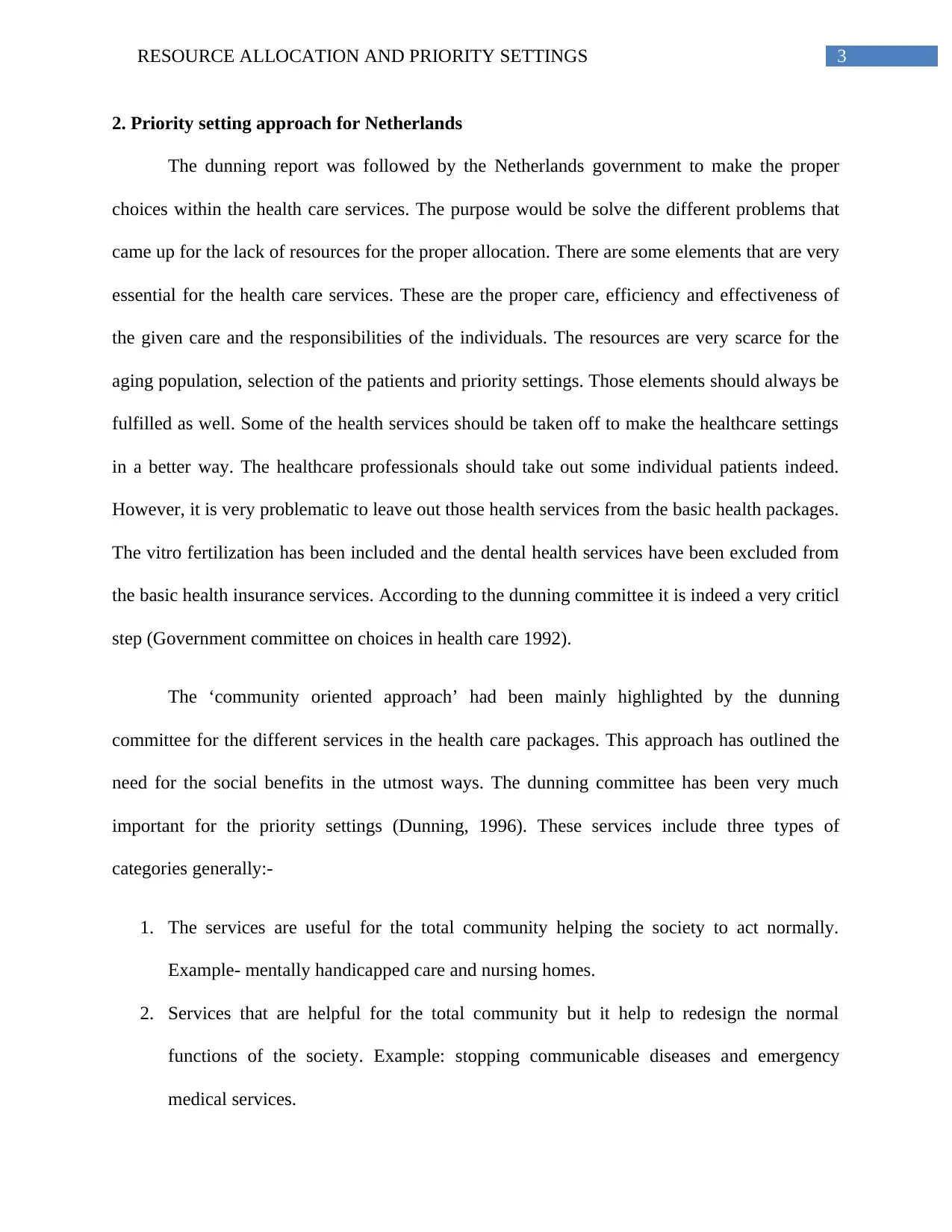
3RESOURCE ALLOCATION AND PRIORITY SETTINGS
2. Priority setting approach for Netherlands
The dunning report was followed by the Netherlands government to make the proper
choices within the health care services. The purpose would be solve the different problems that
came up for the lack of resources for the proper allocation. There are some elements that are very
essential for the health care services. These are the proper care, efficiency and effectiveness of
the given care and the responsibilities of the individuals. The resources are very scarce for the
aging population, selection of the patients and priority settings. Those elements should always be
fulfilled as well. Some of the health services should be taken off to make the healthcare settings
in a better way. The healthcare professionals should take out some individual patients indeed.
However, it is very problematic to leave out those health services from the basic health packages.
The vitro fertilization has been included and the dental health services have been excluded from
the basic health insurance services. According to the dunning committee it is indeed a very criticl
step (Government committee on choices in health care 1992).
The ‘community oriented approach’ had been mainly highlighted by the dunning
committee for the different services in the health care packages. This approach has outlined the
need for the social benefits in the utmost ways. The dunning committee has been very much
important for the priority settings (Dunning, 1996). These services include three types of
categories generally:-
1. The services are useful for the total community helping the society to act normally.
Example- mentally handicapped care and nursing homes.
2. Services that are helpful for the total community but it help to redesign the normal
functions of the society. Example: stopping communicable diseases and emergency
medical services.
2. Priority setting approach for Netherlands
The dunning report was followed by the Netherlands government to make the proper
choices within the health care services. The purpose would be solve the different problems that
came up for the lack of resources for the proper allocation. There are some elements that are very
essential for the health care services. These are the proper care, efficiency and effectiveness of
the given care and the responsibilities of the individuals. The resources are very scarce for the
aging population, selection of the patients and priority settings. Those elements should always be
fulfilled as well. Some of the health services should be taken off to make the healthcare settings
in a better way. The healthcare professionals should take out some individual patients indeed.
However, it is very problematic to leave out those health services from the basic health packages.
The vitro fertilization has been included and the dental health services have been excluded from
the basic health insurance services. According to the dunning committee it is indeed a very criticl
step (Government committee on choices in health care 1992).
The ‘community oriented approach’ had been mainly highlighted by the dunning
committee for the different services in the health care packages. This approach has outlined the
need for the social benefits in the utmost ways. The dunning committee has been very much
important for the priority settings (Dunning, 1996). These services include three types of
categories generally:-
1. The services are useful for the total community helping the society to act normally.
Example- mentally handicapped care and nursing homes.
2. Services that are helpful for the total community but it help to redesign the normal
functions of the society. Example: stopping communicable diseases and emergency
medical services.
Paraphrase This Document
Need a fresh take? Get an instant paraphrase of this document with our AI Paraphraser
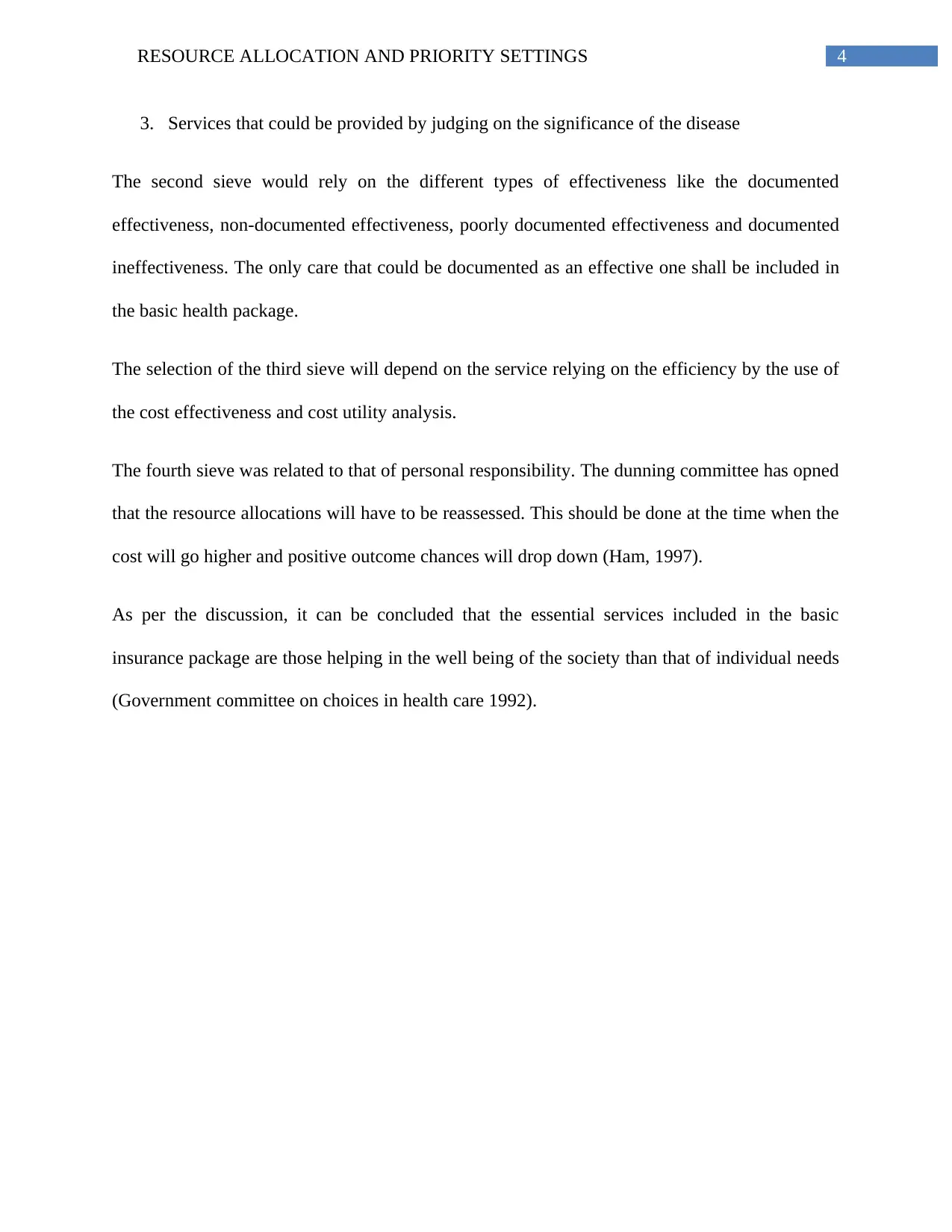
4RESOURCE ALLOCATION AND PRIORITY SETTINGS
3. Services that could be provided by judging on the significance of the disease
The second sieve would rely on the different types of effectiveness like the documented
effectiveness, non-documented effectiveness, poorly documented effectiveness and documented
ineffectiveness. The only care that could be documented as an effective one shall be included in
the basic health package.
The selection of the third sieve will depend on the service relying on the efficiency by the use of
the cost effectiveness and cost utility analysis.
The fourth sieve was related to that of personal responsibility. The dunning committee has opned
that the resource allocations will have to be reassessed. This should be done at the time when the
cost will go higher and positive outcome chances will drop down (Ham, 1997).
As per the discussion, it can be concluded that the essential services included in the basic
insurance package are those helping in the well being of the society than that of individual needs
(Government committee on choices in health care 1992).
3. Services that could be provided by judging on the significance of the disease
The second sieve would rely on the different types of effectiveness like the documented
effectiveness, non-documented effectiveness, poorly documented effectiveness and documented
ineffectiveness. The only care that could be documented as an effective one shall be included in
the basic health package.
The selection of the third sieve will depend on the service relying on the efficiency by the use of
the cost effectiveness and cost utility analysis.
The fourth sieve was related to that of personal responsibility. The dunning committee has opned
that the resource allocations will have to be reassessed. This should be done at the time when the
cost will go higher and positive outcome chances will drop down (Ham, 1997).
As per the discussion, it can be concluded that the essential services included in the basic
insurance package are those helping in the well being of the society than that of individual needs
(Government committee on choices in health care 1992).
1 out of 5
Related Documents
Your All-in-One AI-Powered Toolkit for Academic Success.
+13062052269
info@desklib.com
Available 24*7 on WhatsApp / Email
![[object Object]](/_next/static/media/star-bottom.7253800d.svg)
Unlock your academic potential
Copyright © 2020–2025 A2Z Services. All Rights Reserved. Developed and managed by ZUCOL.




